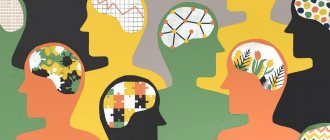Socialization is an integrative process of a subject’s entry into the structure of society, through his mastery of social rules, values, orientations, traditions, the knowledge of which helps to become an effective individual of society. From the first days of his existence, a small person is surrounded by many people, he is gradually included in collective interaction. During relationships, a person gains social experience, which becomes an integral component of the individual.
The process of personal socialization is two-way: a person assimilates the experience of society, and at the same time actively develops relationships and connections. A person perceives, masters and transforms personal social experience into personal attitudes and positions. He is also involved in diverse social connections, performing different role functions, thereby transforming the surrounding society and himself. The real conditions of collective life pose the most pressing problem, requiring everyone to be included in the social structure of the environment. In this process, the main concept is socialization, which allows an individual to become a member of social groups and collectives.
The process of socialization of an individual into social strata is difficult and lengthy, since it includes a person’s mastery of the values and laws of social life, and the development of various social roles.
Personality socialization in psychology is a topic that is actively studied by many social psychologists. After all, a person has a social essence, and his life is a process of continuous adaptation, which requires stable changes and updates.
The process of socialization provides for a high level of internal activity of the individual himself, the need for self-realization. Much depends on a person’s vital activity and ability to effectively manage activities. But this process often occurs when objective life circumstances give rise to certain needs in an individual and create incentives for activity.
What is socialization
Socialization is the acquisition by a person of social experience, in the process of acquiring which the subject acquires ethical and aesthetic values, rules of behavior, knowledge, skills and psychological attitudes characteristic of society.
So that the norm of behavior is socialized, i.e. has become mandatory, it must undergo a process of internalization - become part of the internal structures of the individual’s psyche.
Parents and the environment, through example, persuasion and coercion, instill in the child habits, stereotypes of actions and reactions: brushing teeth, eating with a fork and spoon, fastening buttons, tying shoelaces, etc.
In the process of adaptation of the subject to society, teachers, acquaintances and friends, study and work colleagues, social groups and institutions take part.
What does it contribute to?
Socialization and adaptation make it possible to form in a person’s brain the necessary set of values and rules that he will subsequently apply to the world. These processes begin in childhood, when the parents of a young child begin to lay the foundation for the first mental and physical skills. After this, the person undergoes training in kindergarten, school and college. During this period, he gains more knowledge from other people, continuing to explore the world. Thanks to this, a person learns to communicate with the individuals around him and understands that the form of interaction with them can be different.
In addition, the socialization of the child is very important, as it teaches him self-control. Gradually, a person begins to learn how to react to certain events in his life. Thanks to this, he learns to distinguish between the internal and external worlds.
Socialization factors
The socialization of an individual is carried out under the influence of genetic, individual, personal and social factors.
Microfactors
They take into account the influence of unregulated communities, educational institutions, religious organizations, labor collectives, families and small groups.
Requirements for an individual vary depending on the history of the development of social structures:
- features of property redistribution;
- dominant religious orientation;
- characteristics of labor relations;
- principles of organizing teams;
- state of education.
In conditions of stable progressive development or social crisis, adaptation processes are different. In the latter case, people are alienated from each other, are in a state of lawlessness and a deformed value system.
Macro factors
Social personality is formed under the influence of state institutions. Large social communities create psychological, socio-economic, political, cultural and spiritual differences.
State ideology is important, which:
- Forms the identification of the individual, his social status, development prospects, opportunities for implementation, rights and responsibilities.
- Reinforces a system of values and patterns of encouraged social behavior.
- Creates the media, political parties and public organizations, a system of training and education of the younger generation.
Mesofactors
These include influences on the individual from medium-sized communities. The following leave their mark on the formation of a person’s worldview and behavior:
- A person's nationality. People of the same ethnic group are united by: language, traditions, cultural characteristics, common behavioral stereotypes.
- State religion. Values and shrines enshrined in religious rituals and literature are often distinctive features of a person belonging to a particular faith.
- Specificity of the region. Social, cultural, and historical originality is characteristic of many regions of Russia. For example, Cossacks and Siberians have their own patterns of behavior, traditions, moral standards and spiritual values.
https://youtu.be/JeXOpHT3elc
Resocialization
The concept of personality resocialization is closely related to the stages of growing up. In essence, this term denotes the secondary socialization of the individual, which continues throughout life and includes a constant reassessment of previously accepted values.
Resocialization begins with the child going out into the outside world and observing people with different cultural, social and gender stereotypes. The more such observations a child accumulates, the more work happens in his head: he begins to understand that not all the words of mom and dad are axioms, that there are other points of view and a different view of the world. And under the influence of these factors in adolescence, the individual completes the formation of his personality, leaving some of the previous family attitudes, and replacing the remaining attitudes with others accepted from the outside and regarded by him as more suitable for him personally.
Over time, an individual’s social circle expands more and more, goes beyond the boundaries of school and university, and includes colleagues, friends in the gym, acquaintances from different segments of the population, therefore resocialization as an important element of personality formation is an endless process.
Socialization functions
Social experience is passed on from generation to generation. If there are violations in this process, asocialization of individuals, groups and even states is possible.
Socializing institutions perform the following functions:
- Sociocultural. It determines the possibility of using methods and methods of adaptation, and, if necessary, limits them. For example, in public schools in many countries issues of religious education and upbringing are regulated.
- Integrative. Values and norms are chosen that contribute to the unification of various forces in society and are aimed at its development.
- Relational. Communicates socially expected standards of behavior to young people. Prescribes requirements for different status-role structures and determines the distribution of people in public space.
- Regulatory. Establishes the framework of the normal process of adaptation of the subject to society. For example, unlike the Soviet period, entrepreneurial skills are in demand in Russia today.
- Regulatory. Indicates the boundaries within which individual actions are not condemned by society. Exercises social control over the behavior of an individual. In democratic systems, most executive functions are implemented through self-regulation. Social institutions determine only the general framework and sanctions that society can apply in a given case.
Depending on the selected parameters, sociologists also identify other functions inherent in the adaptation process: compensatory, procreative, communicative-informational, value-oriented, personal-transformative.
Desocialization
The concept of desocialization of the individual is closely related to resocialization, and means the destruction of previously mastered and accepted norms and rules of behavior, the destruction of previous attitudes.
What is it and why is this process needed? This process is used by psychologists when a person’s learned norms of behavior prevent him from successfully fitting into society. In this case, a person must desocialize - abandon previous attitudes, and then resocialize - accept new rules of behavior adopted in the group.
Desocialization is necessary for victims of domestic violence, people who went through wars and lived in combat zones, as well as those who moved to other countries with a different cultural heritage or when re-educating individuals suffering from deviant behavior - alcoholics, drug addicts, criminals. “Reconfiguration” of the head in such cases is necessary, and the process plan usually begins with an assessment of the attitudes that the individual sees as unshakable, and proof that this unshakability is apparent.
Types of socialization
Sciences that study society distinguish the following types of socialization:
- full and partial;
- directional and non-directional;
- family and household;
- professional and labor (organizational);
- subcultural;
- group;
- resocialization;
- gender (sex-role).
A person is formed under the influence of limiting, stimulating, directing and shaping institutions and agents.
Scientists developing sociological theory classify as agents people who are responsible for developing social values in a subject and teaching him cultural norms - teachers, friends, leaders of youth groups, relatives.
No less important influences on people come from the media, churches, law enforcement agencies, the armed forces, businesses, educational institutions and representatives of the administration of educational institutions - public institutions.
Primary socialization
In accordance with the age of the individual, primary socialization can be distinguished - in the first half of life, and secondary, covering maturity and old age.
Inclusion in social structures begins in the circle of family and friends. From a normative and substantive point of view, agents taking part in adaptation processes during this period are classified as informal. Contacts are carried out at the interpersonal level; their form and content are not fundamentally regulated.
In the future, representatives of formal structures - public and state institutions - play a large socializing role. They act on the basis of documents defining the time, order and content of relationships.
Informal institutions function throughout life, but are most influential during the period of personality formation - in childhood and adolescence, as well as in old age. In midlife, formal business relationships come to the fore.
The first patterns of behavior and social sanctions are laid down in the family. Here norms of mutual assistance and moral responsibility are developed. Family education involves:
- participation of an adult in the process;
- an individualized form of transmission of human experience;
- meeting the child's basic needs;
- determining children's attitudes towards learning;
- formation of a person’s level of aspirations through condemnation, indifference, support or approval of his decisions and behavior.
Initial adaptation is often spontaneous and depends on the relationships of family members, lifestyle, their prosocial or antisocial attitudes, material conditions, social status, level of education and composition.
Resocialization
Examples of socialization studied by science contain a process that sometimes occurs in adults in the second half of life - resocialization. It can be caused by the subject consciously or have an unconscious nature. Under the influence of new circumstances, the individual is forced to adapt to the changing requirements of the environment.
The secondary adaptation process is started:
- change in social status and role of a person in society;
- stress factors: death of loved ones, illness, natural disaster, global social conflicts;
- conditions that cause isolation of the subject, for example, ending up in a military school, a psychiatric hospital, a colony, or any other closed institution, with its own norms and values.
Secondary processes occur in different forms:
- Superficial. Only fundamental values and external patterns of behavior are not corrected.
- Adaptive. Norms and rules change to help adapt to the situation.
- Identification. The individual is required to reconsider the basic beliefs and assessments that underlie his self-identification.
Group
The levels of socialization of an individual also depend on the characteristics and composition of the groups to which he belongs in one way or another. A community of people can be considered a group if:
- its members interact regularly;
- there are interaction goals that are common;
- participants act as a single organism and carry out group behavior;
- the group is characterized by self-identification;
- people from the outside define the community as a single whole.
The basis of consolidation is ideology. Members of a team have the same beliefs, values, motives, goals and implement group behavioral patterns.
A person identifies himself as a member of a community and realizes its difference from other social formations. The following parts can be distinguished in the socializing mechanism of a group:
- obligations assumed by a member of the association if he is satisfied with the quality and volume of rewards (benefits) received from interaction;
- assessment by the group and the individual of the consequences of the implementation of mutual expectations, declared norms and goals;
- role changes that occur as a result of the dynamics of the “individual-group” relationship, when there is a correction of the obligations assumed by the parties.
The stages that a subject goes through during role movements:
- No membership. The status is typical for those who have left the team or its potential participants.
- Quasi-membership. People who do not live up to the expectations of the group or who do not achieve full membership are given this status.
- Full members of the group. They enjoy all available privileges and take on the full range of social obligations.
Gender
Spontaneous socialization leads to the fact that a child begins to identify himself as female or male around 3 years from birth, and at the age of 3-7 he already understands that it is impossible to change gender.
Factors that influence gender-role self-identification and adaptation:
- Society punishes unacceptable gender-role behavior and rewards when actions correspond to the gender vector, thereby increasing differentiation.
- The division by gender is influenced by imitation, which is characteristic of children following the example of behavior patterns that exist in the family, at school, and among peers.
It is typical for society that it condemns the feminine behavior of boys, but tolerates it when girls behave masculinely.
Socializing mechanisms based on gender from the point of view of psychology are:
- gender-role behavior patterns;
- understanding gender roles;
- social expectations;
- social reinforcements;
- identification.
Organizational
Means of socialization are used in training employees in different organizational structures.
A positive result of a person’s adaptation process in a company can be stated if:
- the new employee has no uncertainty, fear, or feeling of tension;
- the employee has become accustomed to his professional role, acquired the necessary skills and the required amount of knowledge;
- managers are satisfied with the results of his work;
- the assessment of the labor contribution by management and the team satisfies the employee;
- a new member of the work team wants to develop in the profession and connects his success in life with this.
In order for a person to become a full-fledged part of the structure of an enterprise, he must learn patterns of professional behavior, sociocultural and moral values of the organization.
A company's ability to socialize new members can be assessed by analyzing employee turnover, productivity, and employee commitment to the firm.
Problems that have to be solved in the process of a subject’s entry into the production structure:
- change in human behavior;
- correction of organizational requirements and conditions;
- optimization of interaction between the organizational environment and the new employee.
In addition to the official requirements, during the adaptation process new employees will learn:
- distribution of power;
- unwritten, but mandatory norms and rules;
- approved appearance;
- behavioral stereotypes inherent to the position;
- permissible freedoms in carrying out work schedules and using time for rest.
Early
The problem of socialization arises at the stage of an individual making decisions about certain forms of cooperation with society.
Before the subject assumes full legal obligations and the resulting responsibility, there are ways to first familiarize him with the requirements and norms of social structures, the conditions of interaction with the future social environment.
A person is given the opportunity ahead of schedule to be in the role of a member of a group, to get acquainted with its traditions, patterns of behavior, cultural, ethical and aesthetic preferences.
Social institutions offering early socialization:
- Communities of interests and professions. A person can attend meetings, seminars, and participate in open events organized by such structures specifically for the purpose of familiarizing future members with the terms of cooperation.
- Educational establishments. Before entering a university, you can attend lectures, participate in practical classes, and take preliminary courses at a university, institute, or college.
- Family. Some couples prefer to live together before marriage in order to get to know family relationships better and experience the nuances and problems of living together.
- Religion. A conscious choice of religion presupposes preliminary familiarization with the teaching, the features of its traditions and rituals, literature, and the nature of the lives of followers.
- Armed forces. At some military institutes and schools, permanent courses are organized, where a future officer can live the life of a serviceman, participate in the education process and training, before finally throwing in his lot with the army.
- Penitentiary system. For troubled teenagers who have come to the attention of the police, events are held that give them the opportunity to familiarize themselves with the conditions of detention of prisoners in prisons and colonies, and to experience the social status of a person whose rights have been infringed.
Deviant behavior
Deviant behavior is behavior that deviates from socially accepted norms, principles and standards.
Deviant behavior is not always a sign of something bad: for a patriarchal society, in which it is accepted, for example, that a woman does not have the right to vote, is obliged to hide her face, wear a skirt and remain silent, the behavior of an ordinary European woman will be regarded as extremely deviant, while in Europe they simply will not pay attention to it, since it fits into the standards of behavior accepted there.
The socialization of individuals can occur with disturbances, and then psychologists also talk about deviant behavior - it is because of improper socialization that people become criminals, they show a tendency to violence, cruelty, and illegal actions. Teenagers who are trying to stand out from the crowd and express their “I” also show signs of deviant behavior.
Deviant behavior is always the result of problems with the socialization of the individual, but, unfortunately, the socialization process cannot be written down as a plan and strictly followed.
Stages of socialization
Stages of socialization can be distinguished depending on age:
- The childhood period is the time of formation of the human “I”. Errors and violations at this stage often have irreversible consequences for the individual. According to science, 70% of skills, knowledge, behavioral stereotypes, and character traits are developed at this time.
- Teenage years. It is characterized by a physiological restructuring of the body, entailing strong psychological changes. Young people pay more attention to their appearance and place among their peers, and are faced with choosing a profession.
- The adult stage is the time of human self-realization. Connections with the chosen social group are strengthened, interpersonal communication becomes closer, a spouse is chosen, and the accumulated life experience is passed on to the children.
- The period of life after 50 years and old age is characterized by acceptance of one’s life, full awareness of one’s “I”. There is a gradual decline in physical and mental activity.
Consciousness of group selection
The choice of social group with which you interact is not always up to you. We make a conscious choice when we decide to take up a particular sport, enroll in a certain university, or move to another neighborhood. In this case, we can prepare ourselves for the norms that will most likely be characteristic of the environment in which we will find ourselves, since we will have time to study the issue, work on our reactions and socialization skills.
But sometimes, due to circumstances beyond our control, we find ourselves in an environment that cannot be called successful, and this is especially dangerous for not fully formed individuals - children and adolescents.
In the event of a forced move to a less favorable area, adult family members are able to distance themselves as much as possible from their neighbors and establish contact with them that does not include accepting their social standards of behavior. But a child or teenager, communicating with classmates and neighbors, does not yet know how to resist someone else’s authoritative opinion, and unconsciously absorbs and adopts those norms of behavior that he should not include in his picture of the world as correct.
This problem of personal socialization cannot always be solved by parents prohibiting the child from communicating with “bad” friends, but the environment in which your child grows up is a very important factor in growing up and shaping his personality.
Kinds
Socialization - what it is, how it is viewed
In psychology, it is customary to highlight options for socialization. For example, during sexual intercourse, different gender roles are learned: girl, girl, woman. The family-household form provides opportunities to learn social roles: daughter, mother, wife, etc. The boy takes on the role of son, husband, father and others.
Primary socialization
This type can also be called children's. The process is unconscious; the child is influenced by various environmental factors. It is under their influence that norms of behavior are learned. Parents, relatives, and educators act as guides.
The older the child, the more awareness he begins to show. In age periods this has its own characteristics. For example, a teenager may reject generally accepted norms and behave antisocially. He is faced with a choice of which line of behavior to choose.
The family is the first place where a child develops ideas about approved actions
Scientists were able to prove that primary socialization is possible only under the influence of external factors. Example - Mowgli children (kids who grew up with animals) can adapt to society only until they are 9 years old, then they forever lose the opportunity to return to a normal lifestyle.
Secondary socialization
As we grow older, the process of assimilation of social norms does not stop. A person undergoes secondary socialization, i.e. getting used to different teams. For example, when an individual enters college or university, he has to learn new behavior patterns.
Important! The most difficult process is when moving to another country, as you have to change habits and traditions.
The socialization process is not always easy. In some situations, a person needs the help of a psychologist.
Permanent socialization
Any society is not a permanent entity. Changes occur in it that affect socialization. For example, a couple of centuries ago women did not have many rights, but in the modern world they are already endowed with a large number of privileges.
Changes also occur in the life of every individual. He can choose a new field of activity, move to another city. In society, ideals become obsolete and other values appear. If the process happens gradually, then it is not so stressful.
Everything is different when the changes are revolutionary. In this case, not all people will be able to integrate into the new society. Individuals who have a flexible psyche will most easily cope with the situation. If socialization goes poorly, a person feels rejection and discomfort.
Different approaches
In total, there are two concepts in psychology. According to the first, the essence of socialization lies in the fact that society itself is interested in uniform norms of behavior.
In a work team, everyone has their own role; mastering the rules allows you to increase productivity
A similar theory was adhered to by J. Ballantyne, T. Parsons and others. Another concept is based on the idea that during socialization an individual undergoes internal changes. A similar idea belongs to J. Mead.
Stages
In psychology, it is customary to distinguish several stages of socialization development. The classification is based on the socio-economic aspect.
The first level is pre-labor. It includes the assimilation of basic norms and behavior patterns. The process takes place under the influence of educational factors.
The second level is labor. The individual develops all his abilities and undergoes professional guidance. A social role and status is being formed.
The third level is post-labor. Starts after retirement. At this time, new skills of existence are consolidated, the old system of ideas becomes obsolete. A person is forced to look for new ways of self-expression. Differences between stages reveal the degree of socialization of a person.











